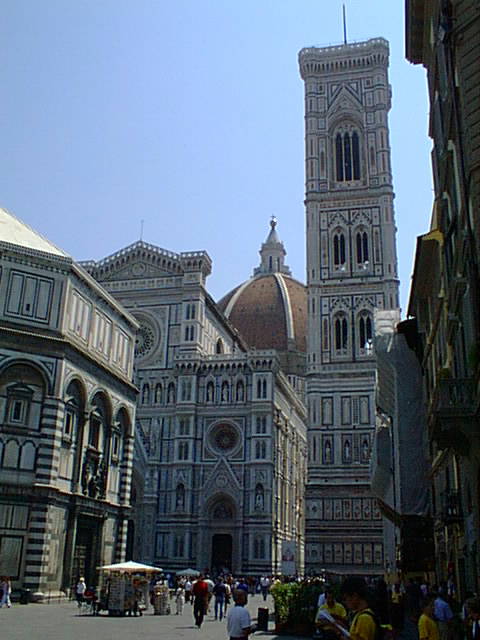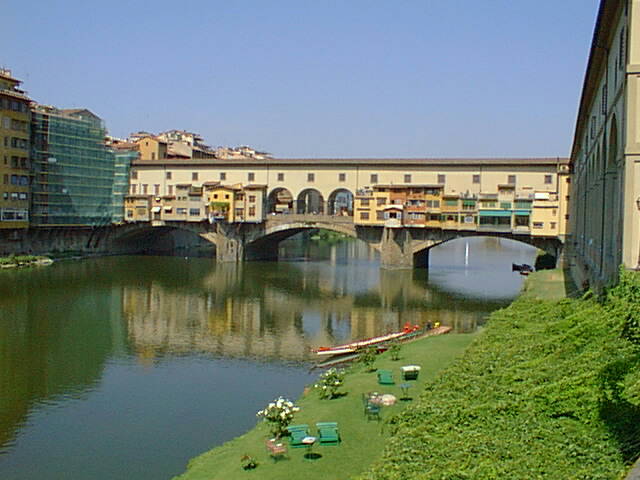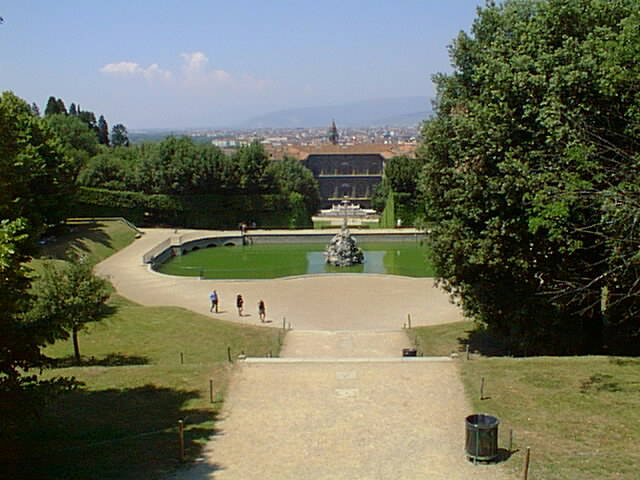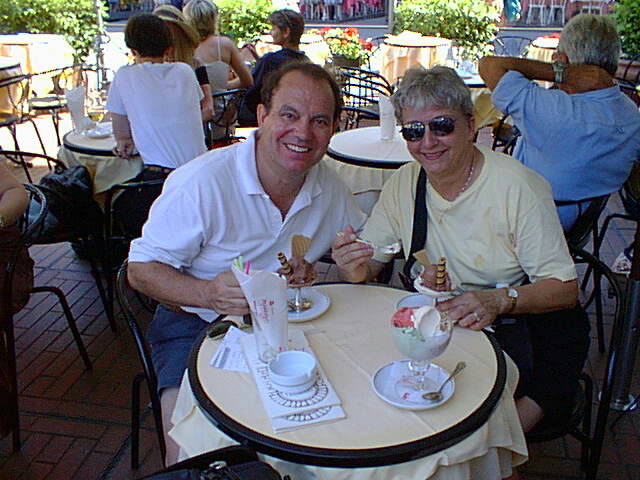
Today was mostly spent looking around the historic and beautiful city of Firenze, or Florence. Some folks who already knew where they wanted to go took public transportation from our hotels in Montecatini Terme early; the majority went via our buses and spent the morning in a very informative guided tour, then went off on our own in the afternoon.

This is a statue of one of Florence's most famous citizens, Dante Alighieri, best known to most of us for his "Divine Comedy". He is revered throughout Italy as the founder of the Italian tongue; in his day the people of the peninsula spoke a myriad different dialects, but as the first major poetry written in Italian rather than Latin, his works crystallized the language into the Florentine form as they were read throughout the country. Sort of the way television pushes most of English-speaking North America in the direction of "Midwestern Standard"...
The statue is in front of the Basilica di Santa Croce (Church of the Holy Cross), where Dante and other famous Florentines and other Italians are buried or memorialized: Michelangelo, Machiavelli, and Galileo have tombs there, and monuments to the scientists Marconi and Fermi stand beside one to da Vinci. The front of the church had been refaced in red, white, and green marble at the time the little kingdoms, duchies, city-states, and what-have-you were united by Garibaldi to create Italy as a nation in the middle of the 19th century; red, white, and green are, of course, the colors of the Italian flag. Florence was actually the first capital of the nation, because it took some time to persuade the Pope to accept reduced secular authority and to rule only Vatican City, not all of Rome; the capital was moved to Rome in the early 1870's and the arrangement with the Pope was finalized by treaty only in the 1920's, I think.
I would have photographed the front of the church, but I couldn't get a clear shot because the Piazza was filled with stands and a field for a special medieval-rules football game that had just taken place! In 1530 an invading army was outside the gates, and the Florentines taunted them by holding loud feasts and games which could be heard by the invaders--just to let them know that they weren't scaring anybody. (They were, in fact, eventually sent packing.) The game has been held in commemoration every year since; there appear to be few rules beyond "no eye-gouging", and the heavy leather uniforms in the heat probably do as much damage to the players as the other team does...

This is the church of Santa Maria del Fiore; we'll be singing there during High Mass tomorrow! The main building and the bell tower, like Santa Croce, were refaced in red, white, and green marble at the time of the unification of the country. The building in the foreground is the baptistery, where in the early days of the church (mentions of the baptistery in surviving records go back at least to the 9th century) converts were baptized outside the cathedral before being allowed inside. The doors, by Lorenzo Ghiberti, on the far side of the baptistery (actually, those doors are copies of the originals, which were removed to a museum to get them out of the weather) are considered by many to be the starting point of the Renaissance period in art, with their more modern use of perspective and realistic detail. It is said that Michelangelo, on seeing the completed work, remarked that if Paradise has doors, they must look like these.

The famous Uffizi art galleries are in the former offices of the Medici family ("uffizi" simply means "offices"), which are attached to the Palazzo Vecchio. This was the old city hall during the period when Florence, as a free city, was a republic led by an elected Mayor; when the Medicis came to power they took it over. Cosimo (I) de Medici, founder of the ruling dynasty, married a wealthy wife who disliked living in this medieval structure, so she had another palace more to her liking built across the Arno river. The picture above is of the Ponte Vecchio, the bridge the family would have had to traverse when crossing the river; the bridge has been there since the 14th century, and the attached buildings were originally used by butchers. When unsold meat spoiled in the heat, they would simply throw it overboard; however, the river flows very slowly or not at all near the bridge, and you can imagine the smell from the stagnant stew below! So the Medicis invited goldsmiths in to displace the butchers, and they are still there (along with sellers of postcards, gelato, souvenirs, etc.). The enclosed corridor above the main bridge was built from the Uffizi all the way across to the new palace, so that rulers and officials could go about their business between the two sides of the river without going out into the sun.
The Uffizi galleries date to the 18th century, when the ruling line of the Medici family died out. The last surviving (childless) sister bequeathed the family's magnificent art collection to the Hapsburg family that ruled Austria, on the conditions that the collection never be broken up and sold, and that it be open to the public. This was, we were told, the first public art museum.

This is a view of the palace across the river, the Palazzo Pitti, taken from its immense and (as you can see) steeply terraced "backyard", the Boboli Gardens. After our morning guided tour was over, I decided I didn't want to face the crowds trying to get into the Uffizi and the museum housing Michelangelo's famous sculpture of David, so I headed out to the Pitti. It was worth the walk; the former private quarters were closed unless you had a reservation, but the "Museum of the Grand-Ducal Treasures" was housed in the main formal reception areas and adjacent rooms. The collection itself was magnificent and varied, but I especially enjoyed the frescoes (floor to ceiling) comparing the Grand Duke and his ancestors to Alexander the Great and other heroes of antiquity or mythology. Very convincing trompe-l'oeil, and dense allegory.

After our day of walking all around Florence in the hot Mediterranean sun, a large number of the group ended up at the "Rivoire" gelateria, which was described by one guidebook as a "Florentine institution"--deservedly, we thought. Here are George & Nancy Jackson, who treated me to a tasty, smooth, and most importantly cold gelato! Then we got back on the buses (or train, for those who were traveling apart from the main group) for the ride back to Montecatini Terme and dinner at the hotel. Later in the evening we sang an informal concert of about an hour at the "Torretta", or (I think) Little Tower, in the hydrothermal baths for which the town is famous. We sang on Thursday (briefly), Friday, and today, and we sing tomorrow, so the tour has started off with a bang; after that we have a rest until next Thursday, and then sing just three more times in the remaining six days of the tour. We can use the break!
 To
Sunday, 4 July 1999
To
Sunday, 4 July 1999 Back
to choir tour itinerary
Back
to choir tour itinerary Back
to choir tour home page
Back
to choir tour home pagenew 3 July 1999, updated 13 July 1999